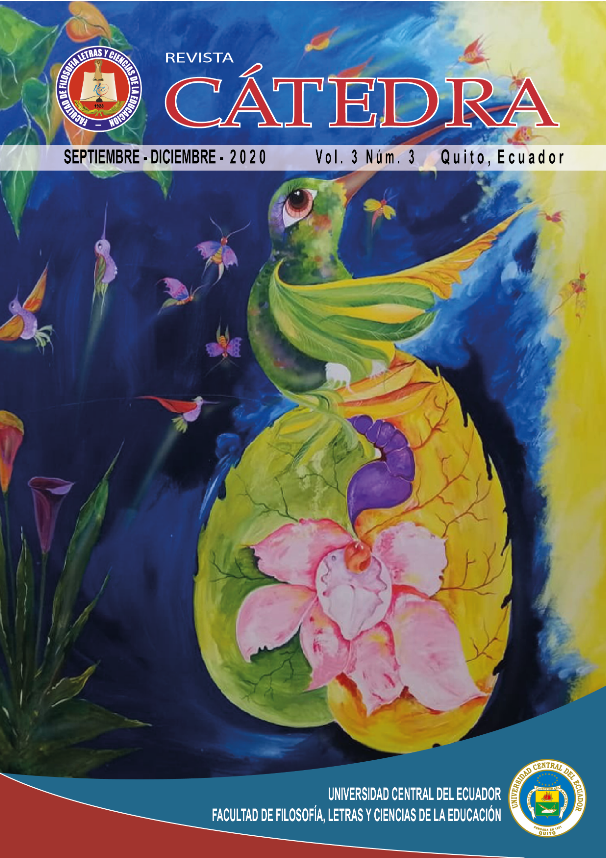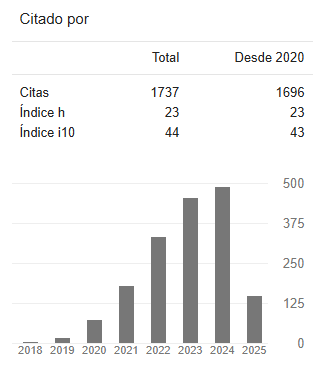Linguistic study about contextual dimensions of political caricature
DOI:
https://doi.org/10.29166/catedra.v3i3.2202Keywords:
Context, political caricature, pragmatics, relevance theory, rhetoricAbstract
Cartoons are one of the most popular journalistic genres in recent decades, combining irony, humor and satire to analyze the relevant facts of a country. Discourse analysis allows establishing a joint relationship between social and cognitive reality in this type of text. This research aims to analyze, from a pragmatic approach, the discourse of Eduardo Sanabria's political cartoon about the 2017 electoral contest in Venezuela under a qualitative approach and descriptive-exploratory design. The analysis of the discourse is the technique used. The corpus was made up of five cartoons published in the newspaper El Nacional days before the elections and whose central topic is limited to the call for elections. The analysis identified the contexts: iconic-linguistic, situational and socio-cultural. Speech acts and rhetorical figures were identified as discursive strategies aimed at evidencing the intentionality of an ostensive communication such as caricature. The contributions of the Theory of Relevance (Sperber & Wilson, 2004) and the Theory of Speech Acts (Austin, 2016; Searle, 2017) were taken into account. A macro-act of illocutionary speech such as the call to vote is evidenced. It is concluded that the discourse of the Sanabria cartoons expresses the criticism of the electoral event from the game of the implicit, discursively constructed between the iconic-linguistic, the rhetorical component and the context, establishing a relationship of complicity with the reader.
Downloads
References
Agelvis, V. (2010). Zapata y la caricatura. Anuario Grhial, 4 (4), 43-62. De http://www.saber.ula.ve/handle/123456789/32815
Austin, J (2016) Cómo hacer cosas con palabras. España: Paidós Ibérica.
Bracho, Ángel (2018). Tratamiento sobre política y economía en la prensa nacional tras el 15 octubre de 2017. Análisis de contenido. Telos, 20 (3), http://www.redalyc.org/articulo.oa?id=993570020010
Bonilla-Castro, E. y Rodríguez Sehk, P. (2005). Más allá de los dilemas de los métodos. La investigación en Ciencias Sociales. Grupo editoral Norma: Bogotá-Colombia.
Calsamiglia, H. y Tusón, A. (1999). Las cosas del Decir. Barcelona: Editorial Ariel Lingüística.
Chirinos, A, Franco, A y León, F (2010). Análisis semio-lingüístico de las caricaturas de Pedro León Zapata. Revista de Artes y Humanidades Única, 1 (1), 15-43.
Escandell, M.V. (2014). La comunicación. Lengua, cognición y sociedad. Madrid: Akal.
Hernández, R., Fernández, C., y Baptista, P. (2014). Metodología de la investigación. México: Mc. Graw Hill.
Morales, E. & Samper, J. (2017). Abordaje discursivo de una caricatura política. Amauta, 15(39), 71-83. http://doi.org/10.15648/am.30.2017.6
Prada, J; Ramirez, J y Pinzón, D (2018). Articulación de la caricatura política como fuente para la investigación social en Colombia: estado del arte y perspectivas a comienzos del siglo XXI. Reflexión Política, vol. 20, núm. 40. https://dialnet.unirioja.es/servlet/articulo?codigo=6837419
Reyes, G. (2007). El abecé de la Pragmática. Arco Libros
Sanabria, E. (13 de octubre de 2017). Vota. Multiplica la señal. El Nacional. Recuperado de https://www.instagram.com/p/BaMM0RqAbL4/
Sanabria, E. (12 de octubre de 2017). Mi novio no va a votar ¿y entonces? Lo voy a votar. El Nacional. Recuperado de https://www.instagram.com/p/BaJoVryAxgW/
Sanabria, E. (11 de octubre de 2017). Salgan todos a votar. No queremos “Abstemios”claro que si… . El Nacional. Recuperado de https://www.instagram.com/p/BaHGJjQAbKe/
Sanabria, E. (9 de octubre de 2017). Que el voto esté contigo. El Nacional. Recuperado de https://www.instagram.com/p/BaCMU4XAw-h/
Sanabria, E. (8 de octubre de 2017). Revise su “circuncisión” y vaya a votar. Si señor… El Nacional. Recuperado de https://www.instagram.com/p/BaCMU4XAw-h/
Searle, J. (2017). Actos de habla: Madrid: Cátedra.
Searle, J. (1994). Actos del habla: Ensayo de filosofía del lenguaje. Planeta-Agostini: Barcelona.
Sperber, D. y Wilson, D. (2004). Teoría de la Relevancia. Revista de Investigación Lingüística, 7, 233-283. De http://revistas.um.es/ril/article/view/6691
Van Dijk, T. (1999). Ideología, una aproximación multidisciplinaria. Gedisa: Barcelona.
Van Dijk, T. (2016). Estudios críticos del Discurso: un enfoque sociocognitivo. En Discurso y sociedad. Vol.10 (1) pp. 137 – 162
Downloads
Published
Versions
- 2021-01-07 (4)
- 2020-11-12 (3)
- 2020-11-12 (2)
- 2020-09-29 (1)









